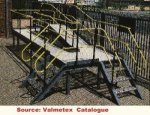1. Open grid Flooring
Rectangular open grid flooring consists of a series of transverse bars forming a rectangular open grid pattern. The bars form the two main components namely:
- The bearer bar - which carries the applied loads.
- The transverse bar - which separates and supports the bearer bars to form a fixed pattern
|
 |
2. Expanded Metal Flooring
Expanded metal flooring consists of a solid sheet of metal that is slit and expanded in a cold drawing operation into a lattice of diamond meshes in which the strands are set at a sharp angle, imparting strength and rigidity to the sheet. The size of the diamond mesh as well as the thickness of the strand have a direct bearing on the strength of the sheet. |

|
Punched Metal Flooring
Punched metal flooring consists of a solid sheet of metal that is slit and punched in in modular panels. The punched areas form a serrated tooth-like pattern which have excellent non-slip properties. The modular panels may be bolted together to form walkways etc.
|
|
Pressed Metal Flooring
Pressed metal flooring consists of a solid sheet of steel which is pressed complete with a slightly protrudingchequered diamond mesh pattern or a protruding nodule pattern. These patterns enhance the non-slip properties of thid particular type of flooring. |
|


